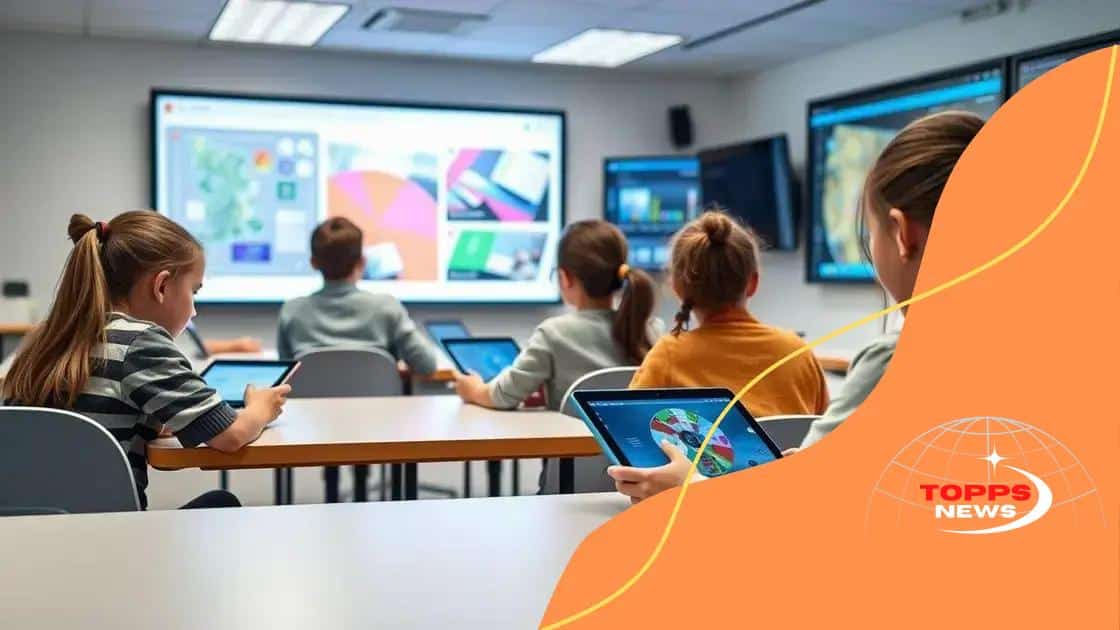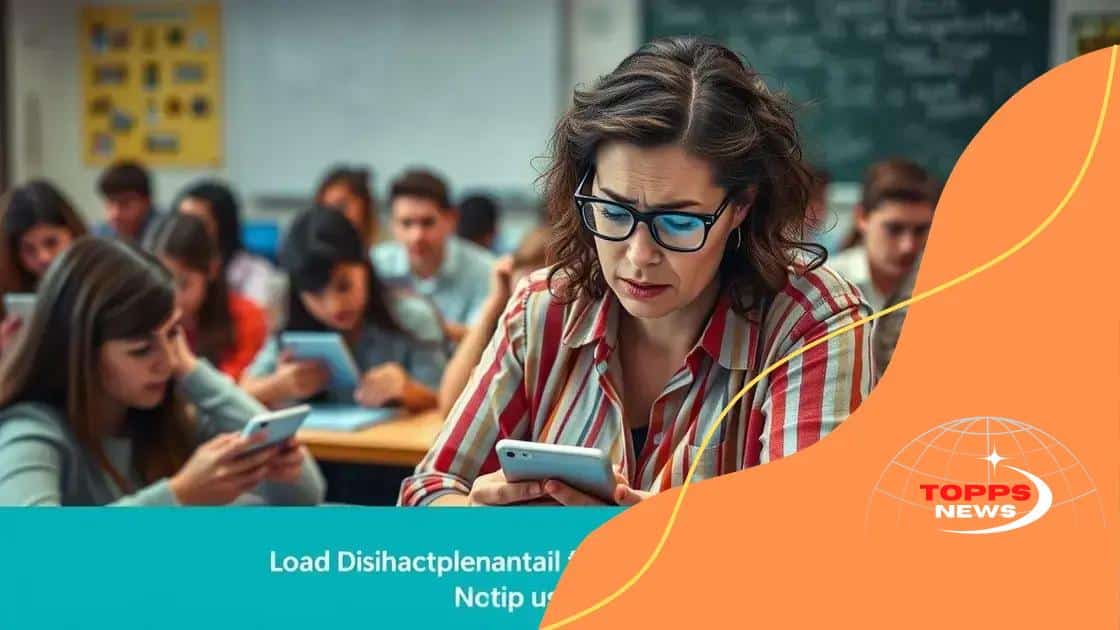The digital environment in schools: transforming education

The digital environment in schools enhances learning by integrating technology, promoting engagement, and personalizing education through tools like AI and blended learning models.
The digital environment in schools is reshaping how students learn and interact. Imagine a classroom where technology enhances education, making learning more engaging and accessible. Curious about how this impacts your child’s education?
Understanding the digital landscape in education
Understanding the digital landscape in education is essential for creating effective learning environments. Today, technology plays a vital role in classrooms, positively impacting both teachers and students.
With the advancement of digital tools, teachers can access resources and materials easily, making their lessons more engaging. Digital learning platforms offer interactive experiences that keep students interested and motivated. Think about video tutorials, online quizzes, and educational apps that can complement traditional teaching methods.
Key Components of the Digital Landscape
Several elements contribute to the digital landscape in education:
- Educational software applications
- Online learning environments
- Interactive whiteboards and projectors
- Virtual classrooms and resources
These tools help customize learning experiences, adapting to each student’s needs. By embracing a variety of teaching methods, educators can cater to different learning styles and preferences.
Moreover, access to the internet enables students to connect with resources around the globe. They can explore different perspectives on a topic, engage in online discussions, or collaborate with peers on projects. The possibilities are endless.
Challenges in Adopting Digital Tools
While there are numerous benefits, there are also challenges in adapting to this digital landscape. Some educators may struggle with integrating technology into their teaching. This can be due to lack of training or resources.
Additionally, the presence of technology can sometimes lead to distractions. Students might find it difficult to focus when they have access to social media and gaming sites. Therefore, creating guidelines and teaching digital literacy is crucial for maximizing benefits.
Understanding how to navigate these challenges helps schools create a balanced approach that emphasizes the positive aspects of technology while minimizing distractions.
Overall, the digital landscape in education is continuously evolving. It’s essential for educators, parents, and students to stay informed about trends and tools that can enhance learning experiences.
Benefits of digital tools in classroom settings
The benefits of digital tools in classroom settings are vast and impactful. These tools enhance learning by making lessons more interactive and engaging. With technology, teachers can access a wide range of resources to tailor their teaching methods.
One key advantage is that digital tools promote active learning. Students can participate in discussions using online platforms, share ideas in real-time, and collaborate on projects more easily. This participation helps to foster critical thinking and problem-solving skills.
Enhancing Student Engagement
Using technology in the classroom can significantly boost students’ interest and motivation.
- Interactive apps provide instant feedback, which keeps students engaged.
- Gamified learning experiences make lessons fun and memorable.
- Video resources can bring complex topics to life.
Such tools cater to different learning styles, making education accessible to everyone. Visual learners might prefer videos, while kinesthetic learners enjoy interactive games.
Access to Resources and Information
Digital tools also provide easy access to a wealth of information. Students can research various topics, explore educational websites, and use online libraries. The internet enables them to connect with experts and gain diverse perspectives.
Moreover, teachers benefit from these resources as well. They can leverage digital platforms to collaborate with other educators, attend virtual workshops, and stay updated on the latest teaching strategies.
Incorporating digital tools into lessons not only modernizes education but also prepares students for a tech-driven world. Being familiar with these tools helps them develop skills that are essential in today’s job market.
Challenges faced by educators in a digital world

In a digital world, educators face unique challenges that require adaptation and innovative solutions. The rapid pace of technological change can sometimes feel overwhelming.
One major challenge is the accessibility of technology. Not all students have equal access to devices and reliable internet, creating a digital divide. This gap can hinder learning opportunities for some students and impact their overall performance.
Managing Distractions
Another issue is the potential for distractions that digital devices can create. While digital tools enhance learning, they can also lead to students being sidetracked by social media, games, or other non-educational content.
- Students may struggle to focus during lessons.
- Teachers need to implement strategies to keep students engaged.
- Setting clear guidelines for device usage is essential.
Additionally, the shift to digital learning can lead to assessment challenges. Traditional testing methods may not effectively measure skills acquired in a technology-rich environment. Educators must explore new ways to evaluate student understanding.
The Need for Professional Development
Professional development is crucial for teachers navigating this digital landscape. Many educators may not feel comfortable using new technology. Providing training and support helps them integrate digital tools effectively.
Schools should encourage ongoing learning opportunities for teachers to enhance their digital skills. With confidence in technology, educators can create engaging, effective lessons.
Moreover, adapting to new tools and platforms requires time and resources which are often limited. Balancing curriculum demands with technology integration can make it difficult for teachers to fully embrace the digital transition.
The role of parents in the digital education framework
The role of parents in the digital education framework is becoming increasingly important. As technology becomes a central part of learning, parents must actively engage in their children’s education.
One critical aspect is ensuring that kids have access to necessary devices and internet connectivity. Parents can support their children by providing a suitable learning environment at home. This involvement helps create a foundation for better learning outcomes.
Encouraging Digital Literacy
Parents also play a significant role in building digital literacy. By guiding their children on how to use technology responsibly, parents can enhance their understanding of online safety and digital etiquette.
- Teach children about maintaining privacy online.
- Discuss the importance of verifying information from reliable sources.
- Encourage respectful communication in digital spaces.
This foundational knowledge not only prepares children for academic success but also for future careers in a technology-driven world.
Being Involved in School Activities
Another vital area for parents is being involved in school-related digital activities. Attend parent-teacher meetings and participate in discussions about digital learning tools used in the classroom. This shows support for educators and helps parents stay informed about their children’s progress.
Engaging in school activities can also give parents insights into how to assist with homework or projects that require digital skills. Collaborating with teachers reinforces the importance of education and technology in their child’s life.
Furthermore, parents can foster a positive attitude towards education by encouraging consistent study habits. Establishing a routine that includes time for digital learning can help students manage their time effectively.
Future trends in school digital environments
The future trends in school digital environments show promising advancements that can transform education. As technology continues to evolve, schools are adapting to create more interactive and inclusive learning experiences.
One significant trend is the growing use of artificial intelligence in education. AI can personalize learning for students by analyzing their strengths and weaknesses. This tailored approach helps educators focus on individual needs, providing support where it’s most needed.
Blended Learning Models
Another exciting trend is the shift towards blended learning models that combine traditional classroom learning with online instruction. This mix allows for flexibility in how students receive information.
- Students can review lessons at their own pace.
- Teachers can offer a variety of resources to accommodate different learning styles.
- Online assessments can provide immediate feedback.
The integration of virtual reality (VR) and augmented reality (AR) also has the potential to enhance learning. These technologies can create immersive experiences, allowing students to explore complex concepts in a hands-on way.
Collaboration Tools
Collaboration tools are becoming essential in the digital classroom. Platforms that facilitate teamwork help students develop critical social and communication skills, preparing them for future careers.
Digital learning environments will increasingly focus on enhancing connectivity among students and teachers. Online forums, group projects, and cloud-based resources foster collaboration, making learning more interactive and engaging.
Additionally, schools will need to prioritize cybersecurity. As digital environments expand, ensuring the safety of student data and online interactions becomes crucial. Training teachers and students on best practices for online safety can help create a secure learning environment.
FAQ – Frequently Asked Questions about the Digital Environment in Schools
What are the main benefits of using digital tools in classrooms?
Digital tools enhance engagement, provide access to diverse resources, and personalize learning experiences for students.
How do parents contribute to digital education?
Parents can support their children by providing access to technology, encouraging digital literacy, and being involved in school activities.
What challenges do educators face in the digital learning environment?
Educators face challenges such as managing distractions, ensuring access to technology, and adapting their teaching strategies to include digital tools.
What future trends should we expect in school digital environments?
Future trends include the use of artificial intelligence, blended learning models, and enhanced collaboration tools to create more interactive learning experiences.





